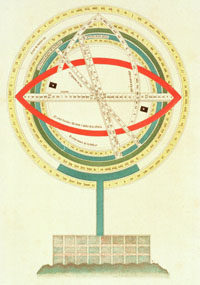The Armillary Sphere
 A drawing of a demonstrational armillary sphere, from Libros del saber de astronomia del rey D. Alfonso X De Castilla.
A drawing of a demonstrational armillary sphere, from Libros del saber de astronomia del rey D. Alfonso X De Castilla.
The armillary sphere described by Ptolemy was a zodiacal instrument of six rings, designed to determine the locations of celestial objects according to the ecliptic co-ordinate system. The sphere was first set to the appropriate latitude by ensuring that its outer fixed meridian ring was perpendicular to the horizon, and parallel to the actual meridian - in other words aligned along a North-South line. The orientation of the instrument was establishing by sighting on a celestial object (the sun or a star) whose position in the ecliptic - that is, its celestial longitude - was known. Two rings, one a divided ecliptic ring, and one corresponding to the latitude component, were used for this task. An inner latitude ring was also divided; nesting within it was another ring to which diametrically opposed sights had been fitted, and which could turn within the latitude ring. By using these sights to observe a celestial body, the position of the body could be determined in ecliptic co-ordinates by reading off the longitude from the divided ecliptic ring and the latitude from the position of the far sight north or south of the ecliptic on the divided latitude ring.
Recommended Reading
Ptolemy, Almagest, especially Book V, Chapter I. Translated by G. Toomer, Ptolemy's Almagest, London 1984S. Schechner Genuth, 'Armillary Sphere', in R. Bud & D. Warner (eds.), Instruments of Science: An Historical Encyclopedia, New York & London 1998, pp. 28-31
This website is no longer being updated.